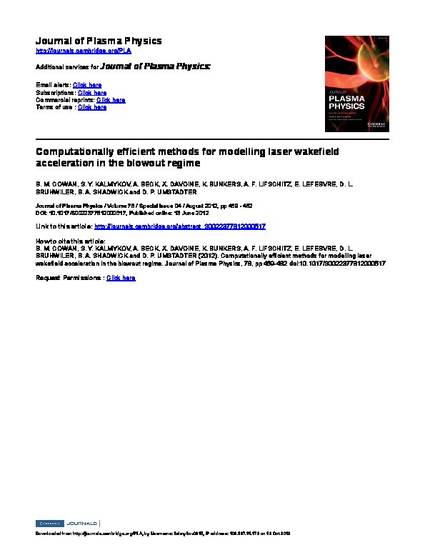
Electron self-injection and acceleration until dephasing in the blowout regime is studied for a set of initial conditions typical of recent experiments with 100-terawatt-class lasers. Two different approaches to computationally efficient, fully explicit, 3D particle-in-cell modelling are examined. First, the Cartesian code VORPAL (Nieter, C. and Cary, J. R. 2004 VORPAL: a versatile plasma simulation code. J. Comput. Phys. 196, 538) using a perfect-dispersion electromagnetic solver precisely describes the laser pulse and bubble dynamics, taking advantage of coarser resolution in the propagation direction, with a proportionally larger time step. Using third-order splines for macroparticles helps suppress the sampling noise while keeping the usage of computational resources modest. The second way to reduce the simulation load is using reduced-geometry codes. In our case, the quasi-cylindrical code CALDER-Circ (Lifschitz, A. F. et al. 2009 Particle-in-cell modelling of laser-plasma interaction using Fourier decomposition. J. Comput. Phys. 228(5), 1803–1814) uses decomposition of fields and currents into a set of poloidal modes, while the macroparticles move in the Cartesian 3D space. Cylindrical symmetry of the interaction allows using just two modes, reducing the computational load to roughly that of a planar Cartesian simulation while preserving the 3D nature of the interaction. This significant economy of resources allows using fine resolution in the direction of propagation and a small time step, making numerical dispersion vanishingly small, together with a large number of particles per cell, enabling good particle statistics. Quantitative agreement of two simulations indicates that these are free of numerical artefacts. Both approaches thus retrieve the physically correct evolution of the plasma bubble, recovering the intrinsic connection of electron self-injection to the nonlinear optical evolution of the driver.
- Particle-in-cell simulation,
- laser wakefield acceleration,
- blowout regime,
- optical shock,
- electron self-injection
Available at: http://works.bepress.com/serguei_kalmykov/4/
